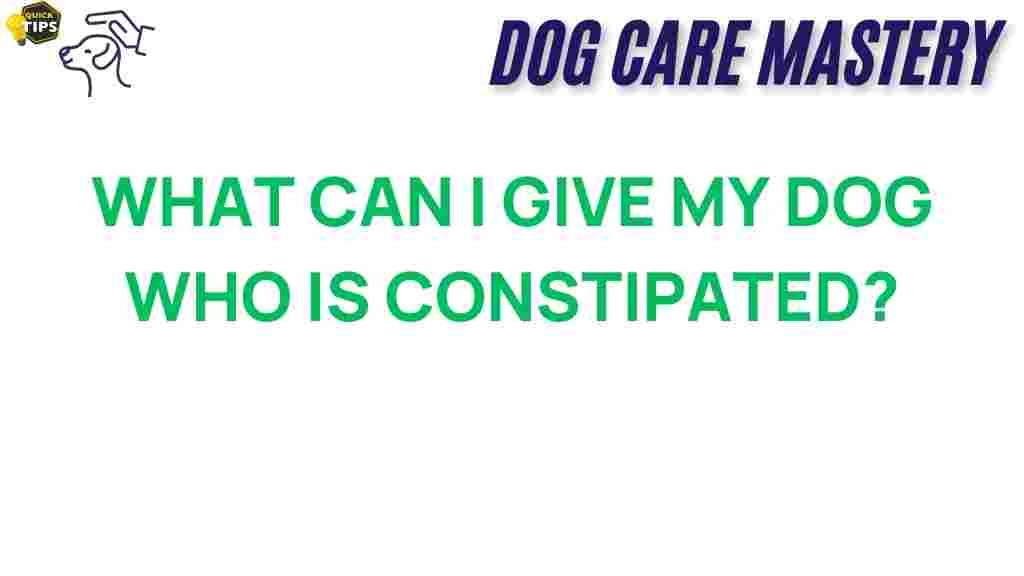Understanding Dog Constipation: Symptoms and Causes
Dog constipation is a common issue that many pet owners encounter. It can lead to discomfort and potential health problems for your furry friend. Understanding the symptoms and causes of dog constipation is crucial in addressing this condition effectively.
Symptoms of dog constipation include:
- Infrequent or difficult bowel movements
- Straining during defecation
- Hard or dry stools
- Vomiting or loss of appetite
- Abdominal discomfort or bloating
Several factors can contribute to dog constipation, including:
- Dehydration
- Lack of fiber in the diet
- Inactivity or lack of exercise
- Medical conditions such as anal gland issues or intestinal blockages
- Certain medications
What Can You Do About Dog Constipation?
If you suspect your dog is suffering from constipation, taking action promptly is essential. Below are steps you can follow to alleviate your dog’s discomfort.
Step 1: Assess Your Dog’s Diet
One of the primary causes of dog constipation is an inadequate diet. Ensure that your dog’s food contains sufficient fiber. You can introduce high-fiber foods such as:
- Pumpkin (plain, canned pumpkin is best)
- Green beans
- Carrots
- Sweet potatoes
Incorporating these foods can help regulate your dog’s bowel movements.
Step 2: Increase Water Intake
Dehydration can lead to constipation in dogs. Ensure your dog has constant access to fresh, clean water. You can also encourage hydration by:
- Adding water or broth to dry food
- Offering ice cubes as a treat
- Providing wet food as part of their diet
Step 3: Promote Regular Exercise
Regular physical activity is vital for maintaining healthy bowel movements in dogs. Engage your dog in daily walks, playtime, or other activities to stimulate their digestive system.
Step 4: Consider a Fiber Supplement
If dietary changes alone do not resolve the issue, consider using a fiber supplement. Products like psyllium husk or commercially available dog-safe fiber supplements can help improve your dog’s bowel movements. Always consult your veterinarian before introducing any supplements.
Step 5: Monitor Your Dog’s Behavior
Keep an eye on your dog’s behavior and stool consistency. If your dog seems to be straining without success or if there is blood in their stool, consult a veterinarian immediately. These could be signs of a more serious condition.
Troubleshooting Dog Constipation
Despite your best efforts, your dog may still experience constipation. Here are some troubleshooting tips to help you manage the situation:
When to Consult a Veterinarian
If your dog’s constipation persists for more than a couple of days or is accompanied by any of the following symptoms, seek veterinary assistance:
- Vomiting
- Abdominal swelling or pain
- Loss of appetite
- Severe lethargy
- Blood in the stool
Possible Medical Treatments
Your veterinarian may recommend treatments such as:
- Laxatives or stool softeners
- Enemas
- Prescription diets
Always follow your veterinarian’s guidance regarding medications and treatments for dog constipation.
Preventative Measures
To prevent future occurrences of constipation, consider the following tips:
- Maintain a balanced, high-fiber diet
- Ensure adequate hydration
- Encourage regular exercise
- Regular vet check-ups to monitor your dog’s health
Conclusion: Keeping Your Dog Healthy and Happy
Dog constipation can be distressing for both you and your pet. By understanding the causes and symptoms, you can take proactive steps to address this condition. Regular monitoring, dietary adjustments, and maintaining a healthy lifestyle for your dog can significantly reduce the risk of constipation.
If you’re looking for additional resources on dog health, consider checking this comprehensive guide on pet wellness. For more information on dog-related issues, visit our blog.
Always remember that when in doubt, consulting with a veterinarian is the best course of action to ensure your dog’s health and well-being.
This article is in the category Health and created by dogcaremastery Team

1 thought on “Uncovering Solutions for Dog Constipation: What Can You Do?”